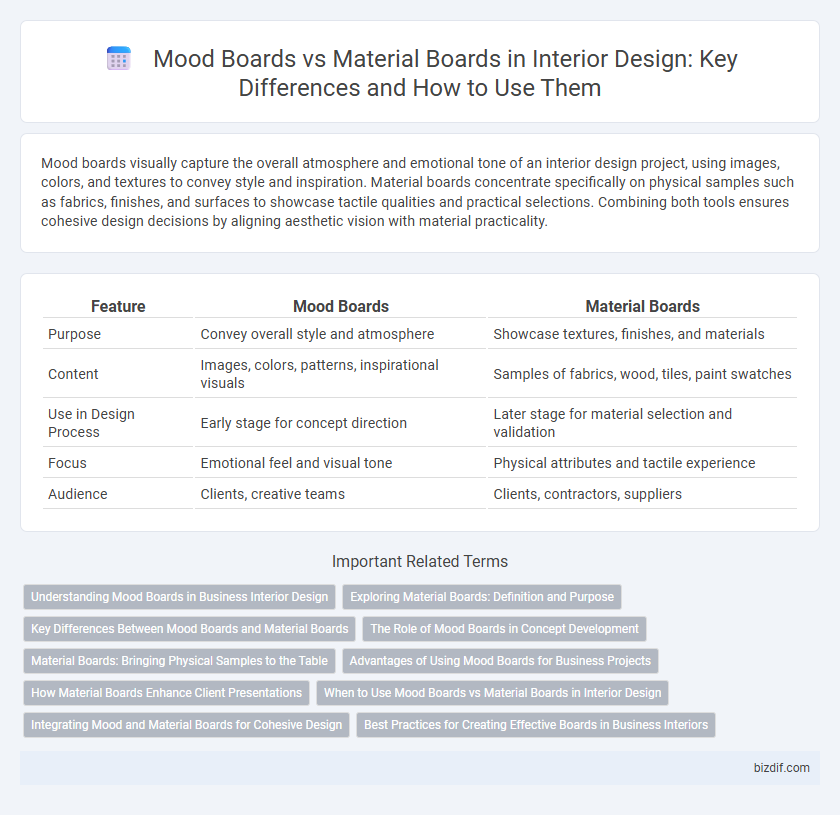Mood boards visually capture the overall atmosphere and emotional tone of an interior design project, using images, colors, and textures to convey style and inspiration. Material boards concentrate specifically on physical samples such as fabrics, finishes, and surfaces to showcase tactile qualities and practical selections. Combining both tools ensures cohesive design decisions by aligning aesthetic vision with material practicality.
Table of Comparison
| Feature | Mood Boards | Material Boards |
|---|---|---|
| Purpose | Convey overall style and atmosphere | Showcase textures, finishes, and materials |
| Content | Images, colors, patterns, inspirational visuals | Samples of fabrics, wood, tiles, paint swatches |
| Use in Design Process | Early stage for concept direction | Later stage for material selection and validation |
| Focus | Emotional feel and visual tone | Physical attributes and tactile experience |
| Audience | Clients, creative teams | Clients, contractors, suppliers |
Understanding Mood Boards in Business Interior Design
Mood boards in business interior design serve as visual tools that convey the overall aesthetic, color schemes, and emotional tone of a workspace, helping clients and designers align on the project's vision. They include images, textures, fonts, and inspirational elements to evoke the desired atmosphere, facilitating decision-making before selecting specific materials. Mood boards streamline communication by capturing abstract ideas and guiding the design direction toward a cohesive and functional office environment.
Exploring Material Boards: Definition and Purpose
Material boards serve as a tactile reference tool in interior design, showcasing actual samples of fabrics, finishes, and textures to ensure cohesive material selection and color harmony across a project. Unlike mood boards that convey overall aesthetic concepts and emotional tone through images and color swatches, material boards provide a concrete, hands-on understanding of surface qualities and durability. This practical approach aids designers and clients in making informed decisions about the physical feasibility and sensory experience of the chosen materials within the interior space.
Key Differences Between Mood Boards and Material Boards
Mood boards capture the overall aesthetic and emotional tone of an interior design project through images, colors, and textures to convey style inspiration. Material boards focus specifically on the tactile and functional elements, showcasing actual samples of fabrics, finishes, and materials to evaluate compatibility and quality. The key difference lies in mood boards emphasizing conceptual vision while material boards prioritize physical substance and practical selection.
The Role of Mood Boards in Concept Development
Mood boards play a crucial role in interior design concept development by visually conveying the overall aesthetic and emotional tone through curated images, color palettes, textures, and typography. They help designers and clients align on the vision, fostering collaboration and guiding decision-making early in the project. Unlike material boards, which focus on specific physical elements like fabrics and finishes, mood boards emphasize the atmosphere and style direction of the space.
Material Boards: Bringing Physical Samples to the Table
Material boards enhance interior design by showcasing physical samples such as fabric swatches, paint chips, and textures, offering a tactile experience that mood boards lack. These boards enable designers and clients to assess the true color, texture, and quality of materials, facilitating more informed decisions. Incorporating material boards streamlines the selection process, reduces costly mistakes, and brings a realistic perspective to the overall design vision.
Advantages of Using Mood Boards for Business Projects
Mood boards streamline client communication by visually conveying color schemes, textures, and design concepts, enhancing approval speed and reducing misunderstandings. They serve as an effective tool for inspiration and creative exploration, allowing designers to experiment with styles and themes quickly before committing to materials. Using mood boards in business projects accelerates decision-making and aligns team vision, ultimately improving project efficiency and client satisfaction.
How Material Boards Enhance Client Presentations
Material boards enhance client presentations by providing tactile samples that allow clients to experience textures, finishes, and colors firsthand, increasing confidence in design decisions. Unlike mood boards, which focus on conceptual visuals and thematic inspiration, material boards offer concrete, physical evidence of proposed elements, bridging the gap between abstract ideas and real-world application. This sensory engagement fosters clearer communication and reduces misunderstandings, leading to smoother project approval and execution.
When to Use Mood Boards vs Material Boards in Interior Design
Mood boards are ideal during the initial concept phase of interior design, helping to define the overall aesthetic, color palette, and style direction. Material boards come into play when selecting specific textures, finishes, and materials to ensure functionality and cohesion in the final design. Using mood boards early facilitates creative exploration, while material boards provide practical clarity before implementation.
Integrating Mood and Material Boards for Cohesive Design
Integrating mood boards and material boards creates a cohesive interior design by aligning visual inspiration with tangible textures and finishes, enhancing both creativity and practicality. Mood boards capture color schemes, styles, and emotional tones, while material boards showcase physical samples like fabrics, wood, and metals that influence the design's tactile quality. Combining these elements ensures a harmonious transition from concept to execution, promoting consistency across all design components.
Best Practices for Creating Effective Boards in Business Interiors
Mood boards capture the overall aesthetic and emotional tone of a business interior, incorporating colors, images, and textures to inspire design direction. Material boards focus on the tactile and functional elements, showcasing samples of fabrics, finishes, and surfaces to ensure material compatibility and quality. Combining both boards provides a comprehensive visualization, enhancing client communication and streamlining decision-making in professional interior design projects.
Mood boards vs Material boards Infographic

 bizdif.com
bizdif.com